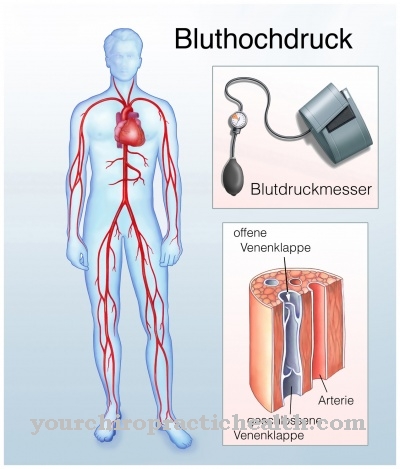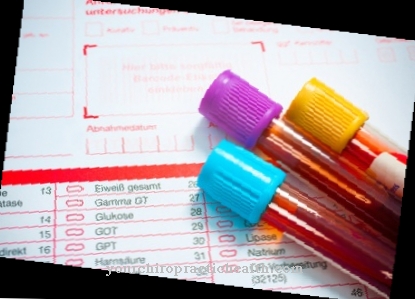A Funnel breast is a funnel-shaped deformity of the thoracic wall due to a disturbed formation of the cartilage connections between the sternum and ribs. With a ratio of 3: 1, men are slightly more likely to have funnel breasts than women.
What is a funnel breast?
As Funnel chest (pectus excavatum) is a visible deformation of the chest wall, which usually affects the 4th to 7th ribs in the lower sternum and, in contrast to the so-called keel or chicken breast, manifests itself in childhood.
Defects in the cartilaginous connections between the ribs and the sternum cause a funnel-shaped depression of the anterior thoracic region, which can be symmetrical or asymmetrical in shape.
Through this funnel, internal thoracic organs such as the heart can be displaced depending on the specific form and, in extreme forms, can lead to cardiopulmonary (heart and lungs) alterations with serious consequences, which cause reduced lung ventilation.
In addition, a funnel chest can be associated with kyphoscoliosis or other diseases as a result of poor posture (lumbar pain, dorsalgia).
causes
The exact causes for a Funnel breast could not be conclusively clarified so far. In most cases, however, the disease is due to genetic factors that lead to soft costal cartilage as a result of impaired cartilage metabolism.
Accordingly, around 35 to 37 percent of those affected have a first-degree relative with this disease in their family. However, the specific gene that triggers the manifestation of a funnel breast has not yet been deciphered.
In addition, a funnel breast is associated with certain syndromes such as Marfan's syndrome in some cases. A funnel chest can also be observed after certain diseases (pleural rind), as a secondary disease of surgical interventions on the diaphragm or chest wall, as well as as a result of greatly increased alcohol consumption during pregnancy (fetal alcohol syndrome).
Symptoms, ailments & signs
The funnel breast is clearly recognizable at birth. Symptomatic is a chest that is pushed inwards. Usually there are no other noticeable symptoms in the first few years of life. Only after puberty and with increasing adulthood do a number of signs appear that are related to the congenital malformation.
Puberty in particular brings psychological stress to people with a funnel-shaped breast. Affected people are ashamed of their bodies and withdraw. Social interaction with people of the same age suffers. In addition, the deformity increases as it grows, which increases the psychological symptoms. Affected people are physically less powerful than other peers.
This extends to the whole of life. Even small loads can lead to breathing difficulties and shortness of breath. In the development phase to become a man or a woman, the heart can sometimes not expand further due to the limited body. In old age, heart problems can then be expected on a regular basis.
It has also been shown that the heart may crush other organs. Those affected have to accept restricted mobility throughout their life. A bad posture often develops in the form of a hunched back. This often results in damage to the intervertebral discs.
Diagnosis & course
A Funnel breast can usually be diagnosed on the basis of the externally visible funnel-shaped depression in the area of the chest wall, which usually occurs in the first year of life and increases until the end of growth.
The deformation is fully assessed using a computed tomography scan of the chest wall. In the context of lung function tests such as spirometry or body plethysmography, impairment of the airways can be determined. Cardiodiagnostic procedures (echocardiogram) provide information about involvement of the heart (mitral valve prolapse).
In addition, other underlying diseases (keel chest, Harrenstein deformity) should be excluded by an X-ray examination of the spine. In most cases, a funnel breast is mild and smooth. However, if left untreated, a funnel chest can lead to malformations of the spine and disorders of the heart or lungs due to incorrect posture.
When should you go to the doctor?
If you have a funnel breast, you should always contact a doctor. In any case, this disease must be examined and treated by a doctor so that there are no further complications or complaints. In the case of this disease, an early diagnosis with subsequent treatment has a very positive effect on the further course of the disease and can also prevent further complications. As a rule, self-healing does not occur. A doctor should be consulted if the person concerned suffers from a malformation of the breast.
The chest is strongly pressed inwards, which can usually be seen with the naked eye. Furthermore, breathing difficulties or, in severe cases, even shortness of breath can indicate the funnel chest. Heart pain also indicates this disease. If the funnel breast is not treated, it usually leads to restrictions in the affected person's movement.
If you have a funnel breast, you can see an orthopedic surgeon or a general practitioner. Further treatment is usually done surgically. Since the illness can also lead to depression or other psychological complaints, a visit to a psychologist is usually necessary.
Treatment & Therapy
The therapeutic measures depend on one Funnel breast on the specific form of the deformity. For example, minor malformations without clinical or psychological impairment are usually treated as part of physiotherapy measures to correct postural errors (postural gymnastics).
An indication for a surgical intervention is derived from the psychological stress caused by the funnel chest and the degree of deformation, and in severe cases, the conservative measures are complemented by surgical correction of the malformation. In most cases, the correction is carried out using the minimally invasive Nuss surgical procedure.
For this purpose, an individually adapted U- or C-shaped metal arch is implanted through an opening in the chest through two smaller incisions in the armpits, which lifts the chest into the regular position and creates space for proximal organs such as the heart. In adolescents, the implant remains in the affected person's body until the end of growth in order to prevent the formation of a new funnel.
In addition, the open correction method according to Ravitch - Welsh - Rehbein is occasionally used, in which the affected ribs are modeled or removed via a horizontal (for men) or vertical (for women) incision on the chest and replaced with implants around the funnel breast to correct.
A purely cosmetic surgical procedure is the filling of the recess with silicone implants. In addition, long-term treatment with a suction or vacuum bell is a relatively new alternative therapy option, with the help of which the sternum is to be regularly raised and the funnel reduced accordingly. However, there are no long-term studies on this treatment option for a funnel breast.
prevention
A genetic one Funnel breast cannot be prevented. However, physiotherapeutic measures, in particular strengthening the back and chest muscles, help to minimize the risk of organ involvement. In addition, excessive alcohol consumption should be avoided during pregnancy in order to avoid fetal alcohol syndrome, which, in addition to other malformations, can also cause a funnel chest.
Aftercare
Surgical treatment is carried out depending on the shape of the funnel breast. Aftercare of the wound, including the removal of the threads, is carried out by the attending physician. Up to six weeks after the operation, it is advisable not to do any sport and, if possible, to lie on your back while sleeping. During this time, pain medication use is usually reduced.
This is also regulated by the doctor. After the six weeks, the patient can start physiotherapy. The patient can also slowly start exercising again. The intensity and amount of sport should be discussed with the attending physician. Certain sports such as boxing are, however, not recommended for the long term in order to avoid damage to the chest area.
It is also advantageous if the patient does not bear any heavy loads for at least three months after the operation. After about a year, follow-up treatments are only necessary as required. An exception to this is the removal of the stirrups three years after the actual operation. The removal is done through another operation. Patients with a funnel breast can also experience psychological stress, which can be treated by a professional therapist.
You can do that yourself
Regardless of the conservative treatment of the funnel chest, which nowadays usually takes place surgically or with suction cups, it is advisable to correct incorrect postures such as a hollow back or drooping shoulders through physiotherapy. Those affected must consciously strive for a natural posture in order to improve their posture in the long term. Regular training and the resulting success also strengthen the self-confidence of those affected.
Patients have to take it easy after an operation. The wound must be properly treated and carefully observed as there is a risk of inflammation or bleeding.
The funnel breast does not necessarily have to be treated. Those affected who decide against therapy should use therapeutic options to make it easier to deal with the deformity of the chest. Attending a self-help group and contacting other affected persons can also be useful if the funnel chest is a significant burden. Most of the time, the parents also have to make sure that the child develops healthy despite the malformation. Exclusion and bullying can occur, especially during puberty. When these situations arise, parents of affected children need to speak to teachers and other parents.

.jpg)



.jpg)
.jpg)










.jpg)







.jpg)


